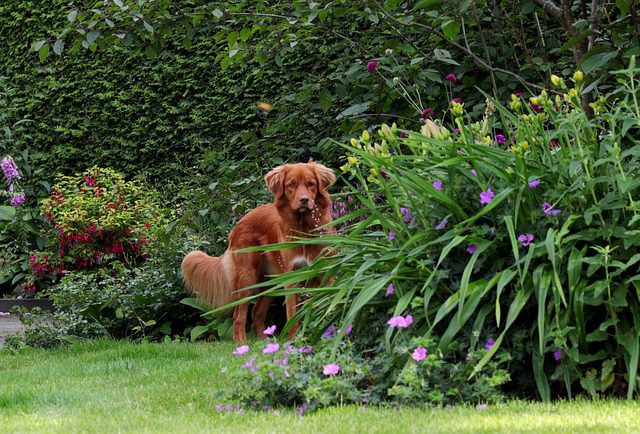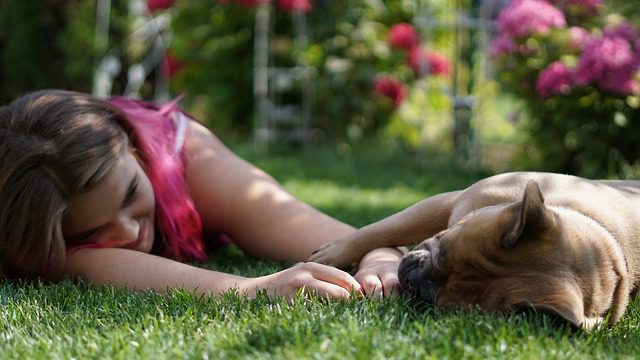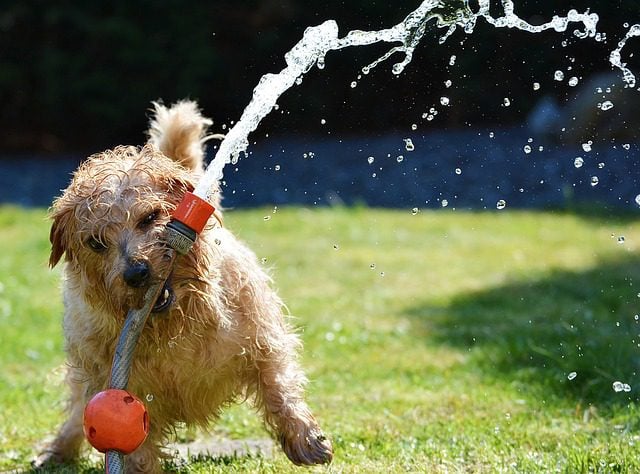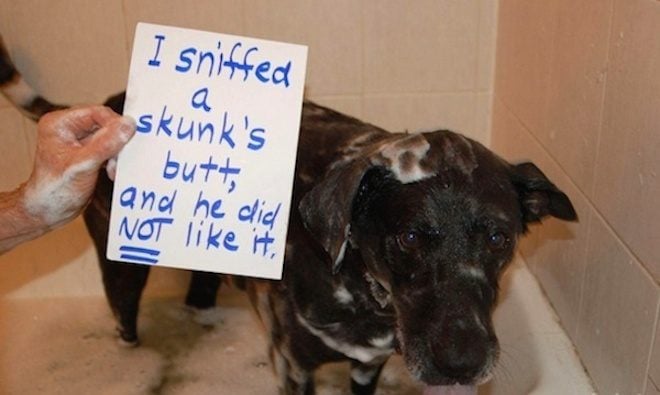Garden and Yard Safety for Your Dog
Gardens and yards are wonderful places to relax with your family, including your dog. But is your yard safety-proofed for your dog? Although it’s not possible to rid your yard of every potential danger, there are a few simple steps that you can take that can help improve your yard’s safety for your dog.
Basic Safety
- Don’t leave garden tools out. Dogs can bite, or step on, rakes, hoes and trowels and other garden tools and hurt themselves. They can also get tetanus (lock jaw) from dirty scrapes.
- Secure garbage bins and composts. Teach your puppy or dog to relieve him/herself in a spot away from this space and clean up after him regularly.
- Puppies are curious and love to explore, so they should always be supervised when outside and corrected in behaviors you do not want to encourage (such as eating plants, digging in the garden).
- Clear mushrooms from the yard and grass as most wild mushrooms are highly toxic to dogs.
- Secure pesticides and chemicals away from their reach and use sparingly (see details below).

Reduce dangers at a dog’s eye level
Examine your yard from a dog’s point of view to remove or fix things that could hurt them accidentally.
- Slowly walk around your yard looking for sharp rocks, uneven stone work, pit holes and other obstacles that could hurt your dogs feet or trip them up.
- Sit on the ground and look around for hazards such as protruding nails sticking out of decks, fences
- Trim pointy branches or thorny bushes that can damage a dog’s eyes or cause injury to their noses, or mouths.
Other tips
- Raised garden beds can help teach a dog what areas they are allowed in and which they are not. It will help protect your plants as well.
- If your dog likes digging, make a digging pit for him, preferably in a shaded location.
Know Your Plants
There are many popular plants that are toxic to dogs. Plants like aloe, ivy, azalea/rhododendron, begonia, daffodils, lilies of the valley, heliotrope, gladiolas can all be harmful to dogs if ingested. The ASPCA has a list of plants that are toxic for dogs. And read our article on Toxic foods for dogs: fruits, vegetables and nuts to know what vegetables and fruits to keep your dog away from.


While it’s not practical to remove every plant in your yard, you should remove the most dangerous ones, especially if you have a puppy. You also will need to train puppies to stay away from certain plants through positive re-enforcement training and by deterring them by sprinkling plants with cayenne pepper or using a commercial non-toxic repellent.
Certain fruit and nut trees can also pose a danger to dogs, such as almond or walnut trees. Fruits and nuts should be picked from the ground to avoid your dog eating them and being either poisoned or obstructing his/her digestive system.
Use Fertilizers and Pesticides in Moderation
Did you know that dogs have an increased risk of bladder cancer* when they are exposed to herbicide treated lawns and gardens? Or that 20% of the calls regarding poisoned pets to the US Animal Poison Control Center are about insecticides? Plants, herbicides and outdoor toxins are also included in their top ten toxins for pets.
Studies have shown that weed killers and lawn herbicides (such as 2,4-D) increase the risk of a dog developing cancerous lymphoma or other cancers. Researchers have also shown a direct connection between higher instances of cancer in dogs and the use of insecticides inside and outside the home. For example, the risk of bladder cancer increases four to seven times in Scottish Terriers, West Highland white terriers, Shetland sheepdogs, beagles and wire hair fox terriers, according to Purdue University veterinary researchers*.
Pests and insects are minimized with pesticides and fertilizers, but they can be harmful to people and dogs. Natural and organic fertilizer products will almost always be safer and reduce the risks of poisoning your dog. It should also be noted that fertilizers are also dangerous to dogs as they may contain heavy metals such as iron (dangerous if ingested).


If you must use herbicides, then be sure to follow manufacturer guidelines, allow gardens and lawns to dry before allowing your dogs out, and wash your dogs’ feet when they comes inside. This will not only protect your home from becoming contaminated, it will protect you and your family from the chemicals as well. It also prevents your dog from potentially ingesting the chemicals if they lick their paws.


Baits for slugs, snails, flies, and rodents are the most dangerous forms of pesticides because of the chemicals they are made of and because they are absorbed by the grass stalks of your lawn which, in turn, can be eaten by dogs. Although it is important to eliminate pests in and around your home and garden to limit exposure to potentially dangerous diseases, such as Lyme Disease or rare ones such as Lungworm, dogs are very often badly poisoned by pesticides.
- Look for fertilizers that are labeled pet-friendly and follow instructions listed on the products.
- Train your dog not to chew outdoor grass if you treat it with any dangerous chemicals. Instead provide them with an organic patch of grass for them to chomp on.
- Wait at least two days before letting a dog out on newly fertilized grass.
- Copper barrier tape is a good alternative to slug bait; slugs and snails are deterred from crossing it by the tape’s tiny positive electric charge.
- Use organic bait traps, like beer traps for slugs and snails.
Pick the appropriate mulch
Avoid using mulch that has cocoa bean shells, which are a by-product of chocolate production. Dogs consuming cocoa bean mulch may develop methylxanthine toxicosis, a condition that can result in symptoms similar to chocolate poisoning. Blood and bone meal fertilizer can also be harmful to dogs. Instead, use less toxic mulching alternatives such as pine and cedar mulch, which are also good at reducing ticks in gardens.
Try to avoid letting your dog play in excavation sites that have a lot of dust or loose dirt (like landscaping a backyard, draining a pond, etc) in case they may become exposed to blastomycosis.
Reduce exposure to ticks, fleas, mosquitos
Dogs should be on regular preventatives for fleas, ticks and heartworm (spread through mosquitos) during pest season. However, these pests can also be discouraged from breeding and living in your garden.
- Mow lawns regularly. Ticks and fleas like to live in long grass.
- Clean up underbrush, leaf litter, and dead sticks. Ticks like to live in underbrush, as do rattlesnakes, if the snakes are in your area.
- If snakes live in your area, place woodpiles in secure areas away from where your dog can reach them.
- If you have deer in your area, remove plants that attract deer, as deer bring ticks.
- Place wood chips or gravel between lawns and wooded areas, and around patios and play equipment as physical barriers to ticks.
- Apply dichotomous earth around the edges of woods, garden areas and homes. It is a natural flea repellent.
- Consider a one-time application of acaricide can reduce the population of ticks that cause Lyme disease by 68-100%. Consult professional pest control experts about the risks to dogs with such a treatment. Read our article: Canine Lyme Disease: Symptoms, Treatment and Prevention.
- Do not let water collect in buckets, lids or large puddles. This will prevent mosquitos laying their eggs in stagnant, still water.


Secure composts
If you have compost piles or bins it is recommended dog owners use tightly sealed containers. Foods disposed of in bins can become moldy and moldy foods potentially contain tremorgenic mycotoxins – poisons from molds that can cause neurological symptoms if digested by animals. Symptoms can include: tremors and seizures, vomiting, hyperactivity, depression, coma, behavior alterations, increase in heart rate, and buildup of fluid in the lungs.
Some composted foods can also be toxic to dogs. Read our article: Toxic foods for dogs: fruits, vegetables and nuts about what foods to avoid composting.
Securing composts will also help keep rodents away. This is important as rodents are carriers of disease through fleas and ticks. They also attract predators such as rattlesnakes, hawks and coyotes – wildlife that can endanger your dog.
Teach water safety
Every year, thousands of dogs drown in swimming pools (sometimes a neighbor’s pool because they can’t get out). If you have a pool, it is important to teach your dog a few basic things to keep him/her safe. Teach your dog how to swim, and show them how to get out of the pool via the stairs or pet ramp so they learn how to get out if they fall in. The same tips should be used if you have a deep pond or other bodies of water near your home. Consider installing immersion pool alarm detectors as extra security.


Once you are satisfied you’ve safety proofed the yard, let your dog have fun outdoors!
* Exposure to herbicide-treated lawns and gardens increases the risk of bladder cancer by four to seven times in Scottish Terriers, according to a study by Purdue University veterinary researchers published in the April 15, 2004 issue of the Journal of the American Veterinary Medicine Association (J Am Vet Med Assoc 2004; 24:1290-1297). The study adds to earlier research conducted by the National Institutes of Health that found elevated rates of canine lymphoma in dogs exposed to lawn pesticides (1991).






